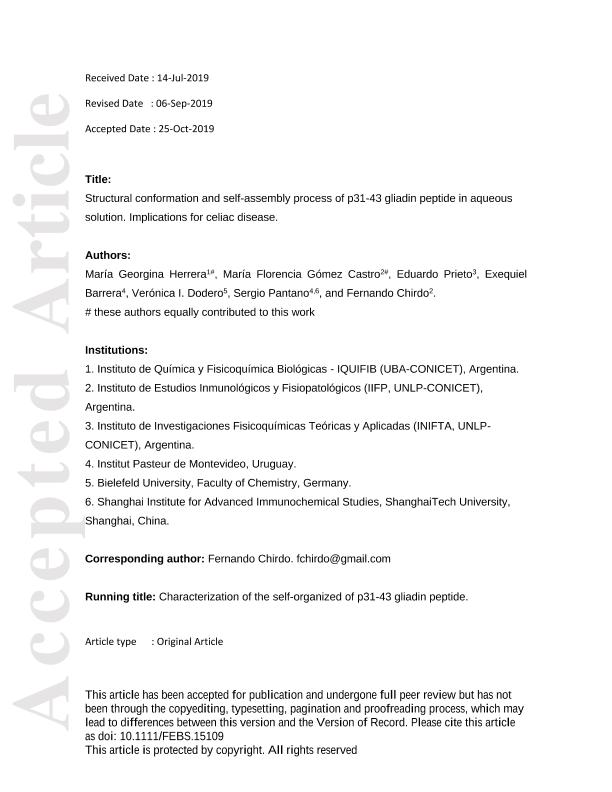Artículo
Structural conformation and self‐assembly process of p31‐43 gliadin peptide in aqueous solution. Implications for celiac disease
Herrera, Maria Georgina ; Gomez Castro, Maria Florencia
; Gomez Castro, Maria Florencia ; Prieto, Eduardo Daniel
; Prieto, Eduardo Daniel ; Barrera Guisasola, Exequiel Ernesto
; Barrera Guisasola, Exequiel Ernesto ; Dodero, Veronica Isabel
; Dodero, Veronica Isabel ; Pantano Gutierrez, Sergio Fabian; Chirdo, Fernando Gabriel
; Pantano Gutierrez, Sergio Fabian; Chirdo, Fernando Gabriel
 ; Gomez Castro, Maria Florencia
; Gomez Castro, Maria Florencia ; Prieto, Eduardo Daniel
; Prieto, Eduardo Daniel ; Barrera Guisasola, Exequiel Ernesto
; Barrera Guisasola, Exequiel Ernesto ; Dodero, Veronica Isabel
; Dodero, Veronica Isabel ; Pantano Gutierrez, Sergio Fabian; Chirdo, Fernando Gabriel
; Pantano Gutierrez, Sergio Fabian; Chirdo, Fernando Gabriel
Fecha de publicación:
10/2019
Editorial:
Wiley Blackwell Publishing, Inc
Revista:
Febs Journal
ISSN:
1742-464X
Idioma:
Inglés
Tipo de recurso:
Artículo publicado
Clasificación temática:
Resumen
Celiac Disease (CeD) is a highly prevalent chronic immune-mediated enteropathy developed in genetically predisposed individuals after ingestion of a group of wheat proteins (called gliadins and glutenins). The 13mer α-gliadin peptide, p31-43, induces proinflammatory responses, observed by in vitro assays and animal models, that may contribute to innate immune mechanisms of CeD pathogenesis. Since a cellular receptor for p31-43 has not been identified, this raises the question of whether this peptide could mediate different biological effects. In this work, we aimed to characterize the p31-43 secondary structure by different biophysical and in silico techniques. By Dynamic Light Scattering (DLS) and using an oligomer/fibril-sensitive fluorescent probe, we showed the presence of oligomers of this peptide in solution. Furthermore, Atomic Force Microscopy (AFM) analysis showed p31-43 oligomers with different height distribution. Also, peptide concentration had a very strong influence on peptide self-organization process. Oligomers gradually increased their size at lower concentration. Whereas, at higher ones, oligomers increased their complexity, forming branched structures. By Circular Dichroism, we observed that p31-43 self-organized in a poly-proline II conformation in equilibrium with βsheets-like structures, whose pH remained stable in the range of 3 to 8. In addition, these findings were supported by Molecular Dynamics Simulation. The formation of p31-43 nanostructures with increased β-sheet structure may help to explain the molecular etiopathogenesis in the induction of pro-inflammatory effects and subsequent damage at the intestinal mucosa in CeD.
Palabras clave:
CELIAC DISEASE
,
GLIADIN P31-43 PEPTIDE
,
OLIGOMERS
,
SECONDARY STRUCTURE
Archivos asociados
Licencia
Identificadores
Colecciones
Articulos(INIFTA)
Articulos de INST.DE INV.FISICOQUIMICAS TEORICAS Y APLIC.
Articulos de INST.DE INV.FISICOQUIMICAS TEORICAS Y APLIC.
Citación
Herrera, Maria Georgina; Gomez Castro, Maria Florencia; Prieto, Eduardo Daniel; Barrera Guisasola, Exequiel Ernesto; Dodero, Veronica Isabel; et al.; Structural conformation and self‐assembly process of p31‐43 gliadin peptide in aqueous solution. Implications for celiac disease; Wiley Blackwell Publishing, Inc; Febs Journal; 287; 10; 10-2019; 2134-2149
Compartir
Altmétricas



